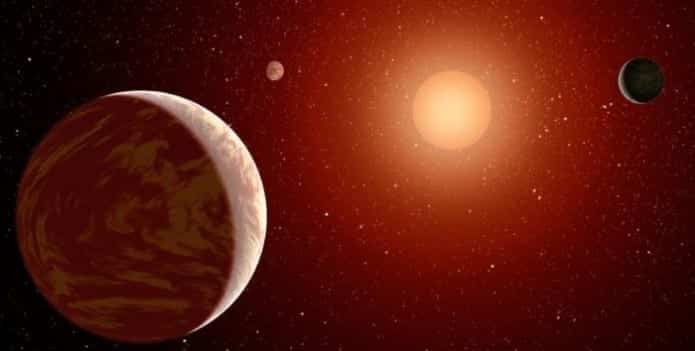Astronomers discover potentially habitable super-Earth orbiting star 14 light years from Earth
Australian astronomers have discovered the closest potentially habitable planet ever found outside our solar system, which is a super-Earth located just 14 light years away. In other words, the rocky orbit, which is more than four times the mass of the Earth is 126 trillion kilometres from Earth.
The newly discovered planet named named Wolf 1061c is located in the constellation Ophiucus, and its star is the 35th closest star from Earth. The team behind the discovery says it’s orbiting a red dwarf ‘M-type’ star called Wolf 1061, alongside two other planets. It is one of three detected by Australian astronomers that orbit a red dwarf ‘M-type’ star called Wolf 1061.
Dr Duncan Wright, a lead researcher and an astronomer at the University of New South Wales (UNSW) said, “It is a particularly exciting find because all three planets are of low enough mass to be potentially rocky and have a solid surface. The middle planet, Wolf 1061c, sits within the ‘Goldilocks zone’ where it might be possible for liquid water – and maybe even life – to exist.”
According to Wright, the discovery is especially exciting because the star is extremely calm, unlike most other red dwarfs that are extremely active which give out X-ray bursts and superflares which are dangerous.
“After looking at several thousand planetary candidates we found that our Sun is a particularly quiet star, even quieter than your average Sun-like star,” said Wright. The Wolf 1061 is also a particularly quiet star, which probably indicates that it’s a very old system, he added.
Of the three planets discovered, the nearest planet orbits the star every five days and is about 1.4 times the mass of the Earth.
The middle planet that is in the star’s habitable zone is about 4.3 times the Earth’s mass and takes 18 days to complete each orbit.
The third planet is just beyond the habitable zone, taking 67 days to complete each orbit and is 5.2 times the mass of the Earth.
“It is fascinating to look out at the vastness of space and think a star so very close to us — a near neighbour — could host a habitable planet,” said Dr Wright.
Dr Wright and his colleagues detected the planets using the so called “wobble method”.
Wolf 1061 is about a quarter of the Sun’s mass and has a surface temperature of about 3,100 degrees Celsius — just over half that of the Sun.
This does not mean that Wolf 1061c is anything like Earth. It has a mass around 4.3 times that of our planet, and orbits its star every 18 days at a distance of around 10 percent Earth’s orbit of the Sun. In our Solar System, that would make Wolf 1061c far too hot for life, but the Wolf 1061 star is much cooler than our Sun, with surface temperatures of around 3,300 Kelvin. The surface of our Sun, on the other hand, regularly hits 5,800 Kelvin.
Planets of similar size are often tidally locked to their parent stars due to the close proximity. Tidal locking is the process by which the same side of an object faces the object it orbits due to the larger mass of the sun or planet it orbits. And at the inner edge of its stars habitable zone, it is likely hotter than our home planet. “This changes the circumstances on the surface of the planet substantially,” he told Marcus Strom at The Sydney Morning Herald. “You have one very hot side and one very cool side.”
The new planet was found by using the radial velocity technique, which involves monitoring the red shift or blue shift (moving away or toward Earth) of a star to indicate the tug of an unseen planet. It uses the HARPS Spectrograph instrument on the European Southern Observatory’s 3.6-metre telescope at La Silla in Chile to observe the star’s movement, rather than the large, Jupiter-sized worlds typically found by radial velocity.
The team will continue investigating the Wolf 1061 trio, picking up on characteristics they can glean from how they transit in front of their star. “The close proximity of the planets around Wolf 1061 means there is a good chance these planets may pass across the face of the star,” one of the researchers, Rob Wittenmyer, told Strom. “If they do, then it may be possible to study the atmospheres of these planets in future to see whether they would be conducive to life.”
The new discovery, spotted at the European Southern Observatory in Chile, will be published in an upcoming Astrophysical Journal Letters.

